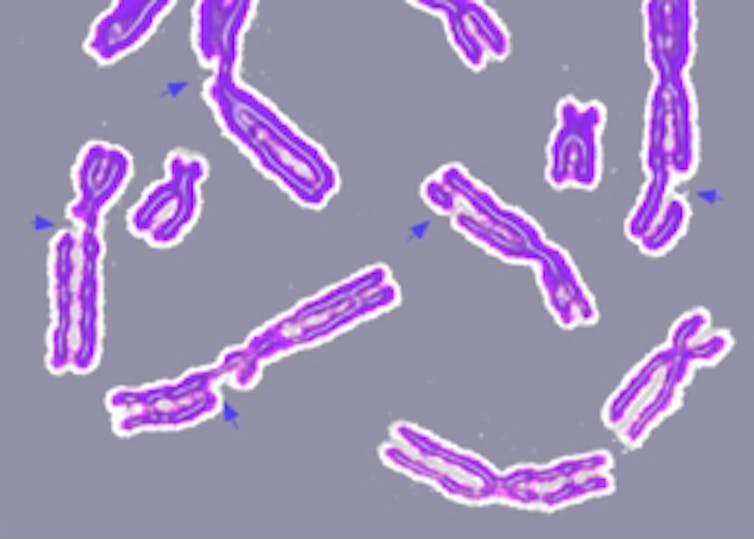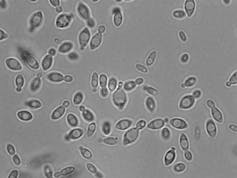An outlaw yeast thrives with genetic chaos – and could provide clues for understanding cancer growth
- Written by Jacob L. Steenwyk, Graduate Student of Biological Sciences, Vanderbilt University
“I fought the law[1],” the 1977 song popularized by the English punk-rock band The Clash[2], features catchy lyrics about the dire consequences of life as an outlaw. In human affairs, the set of rules codified in our laws helps protect individuals and maintain order in our societies. Without rules, order is lost and chaos reigns. Life’s organisms have evolved their own set of checks and balances that help fight off chaos and ensure their survival and success.
We are evolutionary biologists[3] who study the evolution of budding yeasts[4], a group of organisms that includes the baker’s yeast Saccharomyces cerevisiae that is essential for wine-making, brewing, baking, biotech and biofuel industries and several Candida species that cause human infections[5].
During our studies of budding yeast genome evolution, we serendipitously discovered that an ancient lineage of budding yeasts named Hanseniaspora appear to have lost genetic law and order[6]. Specifically, Hanseniaspora yeasts have done away with parts of their systems of checks and balances, in much the same way as cancerous cells do, challenging the existing paradigm that these processes are essential for cellular life.
Checks and balances are evolutionarily conserved
The entirety of an organism’s DNA, or the genome[7], serves as the blueprint for life. From metabolism to movement, the DNA present in each cell contains the instructions for all aspects of its life. Alterations, or in biologists’ lingo “mutations,” in the parts of the DNA carrying these instructions are generally harmful – it is easier to break something than to improve it, and keeping mutations at very low levels is one of cellular life’s major rules.
 Arrows point to breaks in chromosomes, a type of DNA damage.
https://en.wikipedia.org/wiki/DNA_repair#/media/File:Brokechromo.jpg, CC BY-SA[8][9]
Arrows point to breaks in chromosomes, a type of DNA damage.
https://en.wikipedia.org/wiki/DNA_repair#/media/File:Brokechromo.jpg, CC BY-SA[8][9]
Increases in the occurrence of mutations lead to cancer[10] and the death of an organism. Two central mechanisms that help cells do so are cell division and DNA repair processes[11]. These two systems of biological checks and balances not only ensure that cells divide properly but also that they detect and repair any damage that their DNA may have acquired.
Not surprisingly, these functions are largely conserved across living organisms[12], reflecting their fundamental importance and early evolutionary origins. The evolutionary conservation of these two systems runs so deep that, as the Nobel Prize winner Jacques Monod[13] aptly put it, “Anything found to be true of E. coli [a bacterium] must also be true of elephants[14].”
The yeast rule breakers
At first glance, the lives of Hanseniaspora yeasts, close relatives of the more familiar baker’s yeast[15], appear unremarkable. They are typically found on grapes, often making their way into wine fermentation. Though they were originally and most commonly regarded as wine pests, wine makers in more recent years have started to blend them into the wine-making process to diversify flavor profiles of wines[16].
 Hanseniaspora uvarum, a budding yeast species lives without many genes otherwise thought to be essential for life.
Dr. Neža Čadež, University of Ljubljana, Slovenia, CC BY-SA[17]
Hanseniaspora uvarum, a budding yeast species lives without many genes otherwise thought to be essential for life.
Dr. Neža Čadež, University of Ljubljana, Slovenia, CC BY-SA[17]
In a recent study published in PLOS Biology[18], we and our collaborators, including Dana O. Opulente[19] and Chris T. Hittinger[20] from the University of Wisconsin[21], discovered that the lives of Hanseniaspora yeasts are far more chaotic than they first appear.
Why is that so? Because tens of millions of years ago, Hanseniaspora yeasts appear to have lost numerous genes known for their roles in cell division and repairing DNA damage. As a consequence, the genomes of Hanseniaspora yeasts are riddled with many more mutations than other yeast species and show evidence of diverse types of DNA damage, such as that caused by UV radiation, which is associated with skin cancers in humans[22].
In short, like cancer cells, Hanseniaspora have dismissed typical cellular checks and balances and embraced chaos in their genome. But the lives of cancer cells are short-lived because they generally kill their host, whereas the single-celled Hanseniaspora yeasts appear to have inhabited the planet for tens of millions of years. How can they survive without such critical genes? What, if any, was the advantage of losing these genes?
The speed-accuracy trade-off
We believe the Hanseniaspora life strategy is a quantity-over-quality issue. By losing genes that control the pace of cell division, Hanseniaspora cells start dividing too early and speed through the process. Like a NASCAR driver racing through red lights, Hanseniaspora cells sometimes make errors that have grave consequences. For example, their fast-paced cell division can, in the process of dividing, lead to the death of daughter cells.
However, by dividing quickly these yeasts also produce lots of offspring, which means that they can outnumber competing microbes. Strikingly, Hanseniaspora yeasts can divide nearly twice as fast as the baker’s yeast, one of the champions of rapid dividing.
Hanseniaspora uvarum (left) grows roughly twice as fast as baker’s yeast Saccharomyces cerevisiae (right). Video uploaded by Genetik Universität Osnabrück.So, it appears that Hanseniaspora yeasts have fought the law and the yeasts won. Understanding how Hanseniaspora yeasts have done so – a major question we’re now addressing – may hold clues that could one day be used in the war against cancer.
References
- ^ I fought the law (en.wikipedia.org)
- ^ The Clash (en.wikipedia.org)
- ^ We are evolutionary biologists (www.rokaslab.org)
- ^ evolution of budding yeasts (www.sciencedirect.com)
- ^ human infections (www.cdc.gov)
- ^ appear to have lost genetic law and order (journals.plos.org)
- ^ genome (ghr.nlm.nih.gov)
- ^ https://en.wikipedia.org/wiki/DNA_repair#/media/File:Brokechromo.jpg (en.wikipedia.org)
- ^ CC BY-SA (creativecommons.org)
- ^ cancer (doi.org)
- ^ cell division and DNA repair processes (doi.org)
- ^ largely conserved across living organisms (www.nature.com)
- ^ Jacques Monod (en.wikipedia.org)
- ^ Anything found to be true of E. coli [a bacterium] must also be true of elephants (www.ncbi.nlm.nih.gov)
- ^ close relatives of the more familiar baker’s yeast (doi.org)
- ^ diversify flavor profiles of wines (doi.org)
- ^ CC BY-SA (creativecommons.org)
- ^ PLOS Biology (journals.plos.org)
- ^ Dana O. Opulente (www.linkedin.com)
- ^ Chris T. Hittinger (hittinger.genetics.wisc.edu)
- ^ University of Wisconsin (www.wisc.edu)
- ^ skin cancers in humans (doi.org)
Authors: Jacob L. Steenwyk, Graduate Student of Biological Sciences, Vanderbilt University

